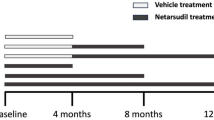Abstract
In this study, we aimed to investigate the effects of topical tramadol administration on corneal wound healing, and examine ophthalmic structures and intraocular pressure 7 days after tramadol administration. The experiments were conducted on eight male Wistar rats (250–300 g). After ophthalmic examination, epithelial cell layers in the central cornea were wounded. Rats received 30 μL of tramadol hydrochloride in one eye (Group Tramadol) and the same volume of vehicle in the other (Group Control) every 12 h for 7 days. Both eyes were stained with fluorescein dye, photographed, and wound area was calculated every 8 h until complete healing was observed. Eye blink frequency and corneal reflex tests were measured before and after drug administrations. After 7 days, slit lamp biomicroscopy, fundoscopy, Goldmann applanation tonometry, and histological evaluation were performed. There was no difference in the corneal wound healing rates between the tramadol and control groups. Reduction in wound area over time was also similar; group-time interaction was insignificant (F = 738.911; p = 0.225). Tramadol application resulted in blinking and blepharospasm for 30 s, but vehicle did not. Corneal reflex was intact and eye blink frequency test results were similar in all measurement times in both groups. Slit lamp biomicroscopy, fundoscopy, and intraocular pressures were within normal range. Corneal cells appeared unaffected by the repeated doses of tramadol for 7 days. Topical tramadol application on the cornea did not cause any side effect, except for initial temporary blinking and blepharospasm. Corneal wound healing was not affected, either.





Similar content being viewed by others
References
Eggers KA, Power I (1995) Tramadol. Br J Anaesth 74:247–248
Lewis KS, Han NH (1997) Tramadol: a new centrally acting analgesic. Am J Health-Syst Pharm 54:643–652
Bianchi M, Rossoni G, Sacerdote P, Panerai AE (1999) Effects of tramadol on experimental inflammation. Fundam Clin Pharmacol 13:220–225
Tsai YC, Chang PJ, Jou IM (2001) Direct tramadol application on sciatic nerve inhibits spinal somatosensory evoked potentials in rats. Anesth Analg 92:1547–1551
Sousa AM, Ashmawi HA, Costa LS, Posso IP, Slullitel A (2012) Percutaneous sciatic nerve block with tramadol induces analgesia and motor blockade in two animal pain models. Braz J Med Biol Res 45:147–152
Marincsák R, Tóth BI, Czifra G, Szabo T, Kovacs L, Biro T (2008) The analgesic drug, tramadol. Acts as an agonist of the transient receptor potentialvanilloid-1. Anesth Analg 106:1890–1896
Bates B, Mitchell K, Keller JM, Chan CC, Swaim WD, Yaskovich R, Andrew J, Mannes AJ, Iadarola MJ (2010) Prolonged analgesic response of cornea to topical resiniferatoxin, a potent TRPV1 agonist. Pain 149:522–528
Zimmermann M (1983) Ethical guidelines for investigations of experimental pain in conscious animals. Pain 16:109–110
Tarantini A, Lanzetta P, Cugini U (2007) Peribulbar tramadol, clonidine, and ropivacaine in blind and seeing painful eyes. Eur J Ophthalmol 17:976–978
McGee HT, Fraunfelder FW (2007) Toxicities of topical ophthalmic anesthetics. Expert Opin Drug Saf 6:637–640
Hendrix DV, Ward DA, Barnhill MA (2002) Effects of anti-inflammatory drugs and preservatives on morphologic characteristics and migration of canine corneal epithelial cells in tissue culture. Vet Ophthalmol 5:127–135
Giuliano EA (2004) Nonsteroidal anti-inflammatory drugs in veterinary ophthalmology. Vet Clin North Am Small Anim Pract 34:707–723
Stiles J, Honda CN, Krohne SG, Kazacos EA (2003) Effect of topical administration of 1% morphine sulfate solution on signs of pain and corneal wound healing in dogs. Am J Vet Res 64:813–818
Wenk HN, Nannenga MN, Honda CN (2003) Effect of morphine sulphate eye drops on hyperalgesia in the rat cornea. Pain 105:455–465
Vickers MD, O’Flaherty D, Szekely SM, Read M, Yoshizumi J (1992) Tramadol: pain relief by an opioid without depression of respiration. Anaesthesia 47:291–296
Preston KL, Jasinski DR, Testa M (1991) Abuse potential and pharmacological comparison of tramadol and morphine. Drug Alcohol Depend 27:7–17
Gaudana P, Ananthula HK, Parenky A, Mitra AK (2010) Ocular drug delivery. AAPS J 12:348–360
Zhao Y, Tao T, Wu J, Pi J, He N, Chai X, Chen Q (2008) Pharmacokinetics of tramadol in rat plasma and cerebrospinal fluid after intranasal administration. J Pharm Pharmacol 60:1149–1154
Edwards A, Prausnitz MR (2001) Predicted permeability of the cornea to topical drugs. Pharm Res 18:1497–1508
Prausnitz MR, Noonan JS (1998) Permeability of cornea, sclera, and conjunctiva: a literature analysis for drug delivery to the eye. J Pharm Sci 87:1479–1488
Murata Y, Masuko S (2006) Peripheral and central distribution of TRPV1, substance P and CGRP of rat corneal neurons. Brain Res 1085:87–94
Wipperman JL, Dorsch JN (2013) Evaluation and management of corneal abrasions. Am Fam Physician 87:114–120
Belknap EB (2015) Corneal emergencies. Topics Companion Anim Med 30:74–80
Karai L, Brown DC, Mannes AJ, Connelly ST, Brown J, Gandal M, Wellisch OM, Neubert JK, Olah Z, Iadarola MJ (2004) Deletion of vanilloid receptor 1-expressing primary afferent neurons for pain control. J Clin Invest 113:1344–1352
Funding
This research was carried out without funding.
Author information
Authors and Affiliations
Corresponding author
Ethics declarations
Conflict of interest
The authors declare that they have no conflict of interest.
Ethical approval
All applicable international, national, and/or institutional guidelines for the care and use of animals were followed.
Rights and permissions
About this article
Cite this article
Cuvas Apan, O., Ozer, M.A., Takir, S. et al. Effect of topical administration of tramadol on corneal wound healing in rats. Int Ophthalmol 36, 675–680 (2016). https://doi.org/10.1007/s10792-016-0184-9
Received:
Accepted:
Published:
Issue Date:
DOI: https://doi.org/10.1007/s10792-016-0184-9




